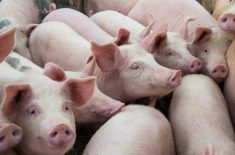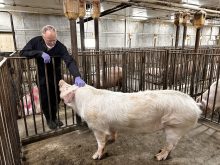For decades, soybean meal and soybeans have been a critical part of pig diets.
Pigs eat soybeans, they gain weight and add muscle. That muscle eventually becomes pork, which humans eat as pork chops, pork tenderloin and sausage.
But now, a European company has found a more direct way of turning soybeans into pork.
Moolec Science, which has headquarters in Luxembourg and business operations in the United States and South America, has developed a genetically modified soybean that contains pork protein.
“The animal protein reached a high expression level up to 26.6 percent of total soluble protein in soy seeds, four times higher than initially projected,” Moolec said in a news release.
Read Also

Short rapeseed crop may put China in a bind
Industry thinks China’s rapeseed crop is way smaller than the official government estimate. The country’s canola imports will also be down, so there will be a lot of unmet demand.
A photo on Moolec’s website shows the difference between its soybeans and standard soybeans. The inside of the Moolec bean is pink, compared to the white or creamy colour of traditional soybeans.
Moolec has branded its novel soybeans as Piggy Sooy.
“(This) represents tangible and visual proof that Moolec’s technology has the capacity to achieve significant yields in plants to produce meat proteins. With this ground-breaking achievement, Moolec consolidates its position as a category creator,” said Moolec chief executive officer Gastón Paladini.
Moolec scientists inserted pork protein DNA into the genetic code of soy to create the Piggy Sooy beans.
“Each protein is selected to add value in terms of targeted functionality like taste, texture and nutritional values,” Moolec said. “We grow crops keeping original plant proteins including animal ones. We scale (production) by using traditional farming techniques.”
Earlier this year, Moolec went public. It is now trading on NASDAQ Capital Markets — a platform for early-stage companies.
Moolec said its researchers have been working on the technology for more than a decade, but adding pork protein to a soybean plant is highly novel and there could be technical barriers to commercialization.
For instance, it doesn’t mention how the pig protein DNA affects the agronomic performance of soybeans.
Regulatory issues could be a much larger obstacle.
Some crop science companies and most public crop breeders have abandoned genetically modified crops because of the cost and time required for approval.
It can take years, or a decade, to register a crop trait developed with GM technology. There’s also the massive cost of human health and environmental safety testing for GM crops, which can run into the tens of millions of dollars.
Because of the regulatory challenges, crop scientists and innovators have shifted to other technologies (like gene-edited crops), which are easier to commercialize.
“The plant breeders are going to (use) the most efficient technology to develop the traits of interest that farmers or the food industry are demanding,” Stuart Smyth, agri-food innovation and sustainability enhancement chair at the University of Saskatchewan, said in 2020.
Moolec is not deterred by the regulatory reality of GM crops. It openly promotes the benefits of GM technology.
Its website includes the following line: “Do we develop GMOs? Yes.”
For now, Moolec is focusing on the North American market.
















